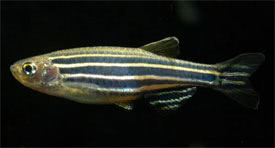
 Magyarul / Hungarian
Magyarul / Hungarian


- Scientific name: Danio rerio
- Synonyms: Barilius rerio, Brachydanio frankei, Brachydanio rerio, Cyprinus chapalio, Cyprinus rerio, Danio frankei, Danio lineatus, Nuria rerio, Perilampus striatus
- Common name: Zebra danio
- Group: Cyprinids
- Habitat: Asia; Eastern India and Bangladesh.
- Size: 5 cm
- Biotope: Found in clear fast flowing streams and similar waters. They tend to stay in large open areas near the surface.
- Social behavior: An active schooling species which can be kept in almost any community tank. Do not combine the Zebra Danio with species that are frightened with constant movement. The Zebra Danio forms pairs, and will often not spawn with different partners.
- Diet: Flakes, live, Drosophila, other insects, insect larvae, crustaceans; occasionally algae.
- Breeding: Easy
- Tank: Minimum 50 litres
- Population: 8 fish for 80 litres
- Decoration: The tank should have large, open swimming areas and a tight-fitting cover. A substrate of coarse gravel or pebbles is recommended. Use planting along the sides and back of the tank. This species is a jumper-so cover the tank well.
- Temperature: 22-27 °C
- pH: 6,5-7,5
- Hardness: 12-14NK°
- Lifespan: 5 years
Description: Although, not a stunning fish the Zebra is handsome in its own way. The background color is leans toward gold in the male and a paler Yellow in the female. There are four long Blue / Black stripes that run the length of the body from head to tail. The combination give a stripped effect and the basis of the common name. The anal and caudal fins has the same pattern. The top portion of the body is Brown and the belly area a pale Yellow.
In their home waters the zebra is extremely active and always on the move. We need to provide for this in our home aquariums. The tank should be fairly large with length being more important than height. The ideal tank should be at least thirty inches in length. Decorate the tank with plantings and rockwork, but always leave plenty of open space for swimming. They will take all types of commercial food from live, flake to frozen. They are a hardy species that are not overly demanding in their water conditions and make the ideal fish for the cycling of the tank. Today we see many inbred and twisted zebras in the store tanks, and it would be nice to see some fresh importation from the wild to give vigor back to our tank-bred strains.
Zebras are one of the easiest fish to breed providing you meet certain requirements. Condition the zebras with the best food possible (white worms, or tubifex ) for a week or so. Then you will need a separate tank, Preferably 5-10 gallons. The tank should have gravel or marbles on the bottom and the water level kept low or the fish will eat the eggs as soon as they are laid. Put several conditioned Danios in the tank to make sure you have both male and female. Watch for the spawning activity. Once the eggs are laid they fall in between the marbles and the parents cannot eat them. Once a few hours have passed remove the fish. The eggs should hatch in a day or so and if after a couple of days you see no fry you may try again after the fish are rested and reconditioned. Raising the fry can be difficult. Once they are free swimming you should feed them with finely ground flakes, paramecium, inforusia or commercial liqui-fry.








